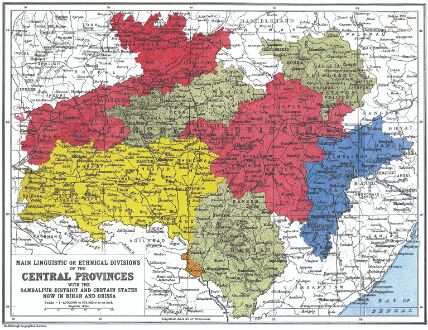'Bande Utkal Janani' - II
In the second part, the numerous contributing factors to the framing of Oriya nationalism are explored in relation to the demand for ‘Natural Oriya’ and the eventual formation of Odisha as a separate state of India

In her essay on the 'Vernacular in the Making of Modern Orissa', Pritipuspa Mishra says that by the third decade of the last century Oriya groups lobbying for the formation of a separate province of Orissa had named the proposed province 'Natural Orissa'. The term 'natural' was deployed strategically: it lent both historical and political legitimacy to the demand for a separate province. In 1903, it found support in the HH Risley, the colonial administrator, ethnographer and linguist who argued that the "Oriya speaking 'plainsmen' and 'hill men' (read Adivasi) should be united under a single administration despite the racial difference, because the connection between a spoken language and its dialect or patios is a more potent ground of union than a purely racial difference is one of separation." The same year, the Utkal Sammilani or the Utkal Union brought the Oriya speaking elite of Bengal, Central Provinces and Madras as well as of the princely states to press the demand for a Natural Orissa, in contrast to the 'colonial Orissa' where the Oriyas were subject to the domination of the 'Intermediary Ruling Class'.
Intermediary Ruling Class
This term was first used by Madhusudan Das to refer to the Bengalis and Biharis in the context of their sway in district and sub-district level administration — as revenue, judicial and police officers, besides of course teachers, postmen and railway employees. The day to day contact of the man in the mofussil was not with the ICS officer, but with the functionaries mentioned above: this refrain was seen even in Assam where the anti-Bengali sentiment also became strong, reinforced by the superior and patronising attitude of the Bhadralok! This term became part of the memorandum submitted to the Orissa Boundary Commission. Sometimes one wonders that if the Bengal intelligentsia — starting from Rajender Lal Mitter and SN Banerjea, had accepted the fact that Oriya was an independent language, and not opposed its teaching tooth and nail, Bengal could have continued as a bilingual state in which two languages could have existed side by side. Recent scholarship also shows that perhaps the 'commercial interests' of the Calcutta publishers of textbooks in Bengali led Headmaster K Bhattacharya to write the polemical 'Odiya is not an independent language'.
Strategies for the linguistic province
A threefold strategy was in place. The first was an appeal based on facts and figures to the provincial and imperial (Viceroy's council), the second was an impassioned plea to the Congress leadership, and the third was a passionate campaign for the masses through the Oriya Press. Madhusudan Das was the lead exponent of the first and Gopabandhu Das of the second. Works of popular authors like Fakir Mahapatra, especially his translations of Mahabharata and Ramayana played a stellar role in making Oriyas feel proud of their language. Mahatma Gandhi's support for linguistic provinces was important for Oriyas — because prior to this, the Congress leadership under SN Banerjea, had been opposed to this assertion. However, the credit for the standardisation and printing fonts in Oriya should be attributed to the Missionaries. In fact, it can also be postulated that but for the spread of printing, the Oriya language movement could not have taken the form it took.
It must also be noted that both Madhusudan Das and Gopabandhu Das did not posit Oriya nationalism against Indian nationalism. Rather it was part of the Indian nation or 'Bharat Varsha'. 'Orissa's river is called Mahanadi, or the great river, Orissa's sea is the Mahodadhi or the great sea, Orissa's hill is Mahendra or the great mountain. Orissa's tree is Kalpabatta (Kalpataru) or the tree of wish fulfilment, Orissa's Lord is Jagannath or the Lord of the Universe and Orissa's cremation ground is the Swargadwara or the gateway to heaven.
Cult of Jagannath
This brings us to the cult of Jagannath, the most potent symbol of Oriya nationalism and pride. It served as a site of exception to caste and religious exclusion by allowing lower castes and Adivasi communities to have access to the deity during the annual 'Rath Yatra'. At the same time, this single annual event came to serve as an example of enduring inclusion of religious and caste differences in Orissa as a region. It included within its frame multiple identities: the regionally important folk deities and diverse motifs of tribal religion. Lord Jagannath is, of course, the Supreme Lord, but also incorporates a distinct Sabara Adivasi origin. Telugu fishermen look up to him as their Lord father and women from all strata, including the outcaste women like Shreya Chandaluni, are his ardent worshippers, while all the little kingdoms were happy to be part of the great tradition of Jagannath in some form or the other. Also, Lord Jagannath had adherents from all groups, including Christians and Muslims. In fact, one of the first acts of the first Prime Minister of the newly carved province of Orissa, KC Gajapati Narayan Dev, the Raja of Paralakhimedi was to pay a ceremonial visit to Lord Jagannath, and even the roots of Mahatma Gandhi's decision to start his Padyatra from Puri may be traced to the nationalistic feelings of Oriyas for Lord Jagannath.
The writer is the Director of LBSNAA and Honorary Curator, Valley of Words: Literature and Arts Festival, Dehradun Views expressed are personal



